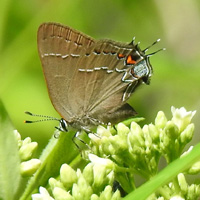Northern Oak Hairstreak
Scientific name: Satyrium favonius ontario

Photo credit: Mike Cowlard
Status
Threatened
“Threatened” means the species lives in the wild in Ontario, is not endangered, but is likely to become endangered if steps are not taken to address factors threatening it.
Date added to the Species at Risk in Ontario List
January 29, 2024
Read the assessment report (PDF)
What it looks like
Northern Oak Hairstreak is a small brownish-grey butterfly with a wingspan of 24 to 38 mm and ‘tails’ on the hindwings.
The undersides of its wings are brownish-grey with prominent orange patches near the hindwing margins. It has a blue patch below the lower tail. There is a series of white and black dashed lines on the hindwing undersides and the white median line forms a "W" marking above the blue patch.
Eggs are rusty brown and flat-disk in shape. Caterpillars are yellowish and slug-like with green and yellow stripes. When metamorphosing, the cocoon is dark brown with fine hairs.
Where it lives
Northern Oak Hairstreak ranges from southern Ontario and Massachusetts south to Georgia, and west to Michigan, Kansas, Colorado and Arizona.
Northern Oak Hairstreak live in oak forests with a closed canopy. In early development, caterpillars feed on pollen from buds and flowers. Prior to metamorphosis, caterpillars eat young tree leaves. White Oak is the preferred tree species of the Northern Oak Hairstreak.
The Committee on the Status of Endangered Wildlife in Canada (COSEWIC) notes the Northern Oak Hairstreak forest habitat may also include the following species:
- Hickory (Carya)
- Sugar Maple (Acer saccharum)
- White Pine (Pinus strobus)
- Black Walnut (Juglans nigra)
Adult Northern Oak Hairstreak visit meadows close to oak forest edges for nectar. COSEWIC notes Northern Oak Hairstreak prefers Hemp Dogbane and Daisy Fleabane nectar in Ontario. Northern Oak Hairstreak have also been observed on the following species:
- Milkweeds (sclepias)
- New Jersey Tea (Ceanothus americanus)
- Thistles (Cirsium)
- Common Yarrow (Achillea millefolium)
- Grey Dogwood (Cornus racemosa)
Where it’s been found in Ontario
In Ontario, Northern Oak Hairstreak has a very small range with only a few locations. It is currently known to occur in the following areas of southwestern Ontario:
- County of Lambton
- County of Essex
- County of Middlesex
What threatens it
The main threat is pesticide application to control Spongy Moth, especially when the pesticide is applied during the species’ larval period. Other threats include:
- agricultural and forestry effluents (discharges)
- invasive species
Action we are taking
This species and its habitat are protected under Ontario’s Endangered Species Act, 2007 (ESA).
The ESA also requires us to prepare recovery guidance for threatened species such as Northern Oak Hairstreak.
All species listed on the Species at Risk in Ontario List may be eligible for consideration for government funding through the Species at Risk Stewardship Program.
What you can do
Report a sighting
Submit your observations of species at risk to the Natural Heritage Information Centre (NHIC), which is Ontario’s conservation data centre. Join the “(NHIC) Rare Species of Ontario” project in iNaturalist to make submitting your observations quick and easy.
Volunteer
Volunteer with species at risk programs, such as community science surveys, through your local nature club, a provincial park or other conservation organizations.
Be a good steward
- Private landowners have a very important role to play in species recovery. If you find species at risk on your land, you may be eligible for stewardship programs that support the protection and recovery of species at risk and their habitats. Learn more about the Species at Risk Stewardship Program.
- Invasive species seriously threaten many of Ontario’s species at risk. To learn what you can do to help reduce the threat of invasive species, visit:
- As with all wildlife, be respectful and observe from a distance.
Report illegal activity
Report any illegal activity related to species at risk to
Quick facts
- Hairstreak butterflies have hair-like tails on their hindwings, giving rise to their common name.
- Northern Oak Hairstreak is of interest because of its association with rare oak-dominated woodlands of southern Ontario.
- Northern Oak Hairstreak is native to Ontario. It was first found in 1868 and there are over 150 records. In the past, it was primarily found in Port Stanley and Grimsby.
- Northern Oak Hairstreak often roost upside down and rubs their wings together to move their tails in a manner that resembles antennae.